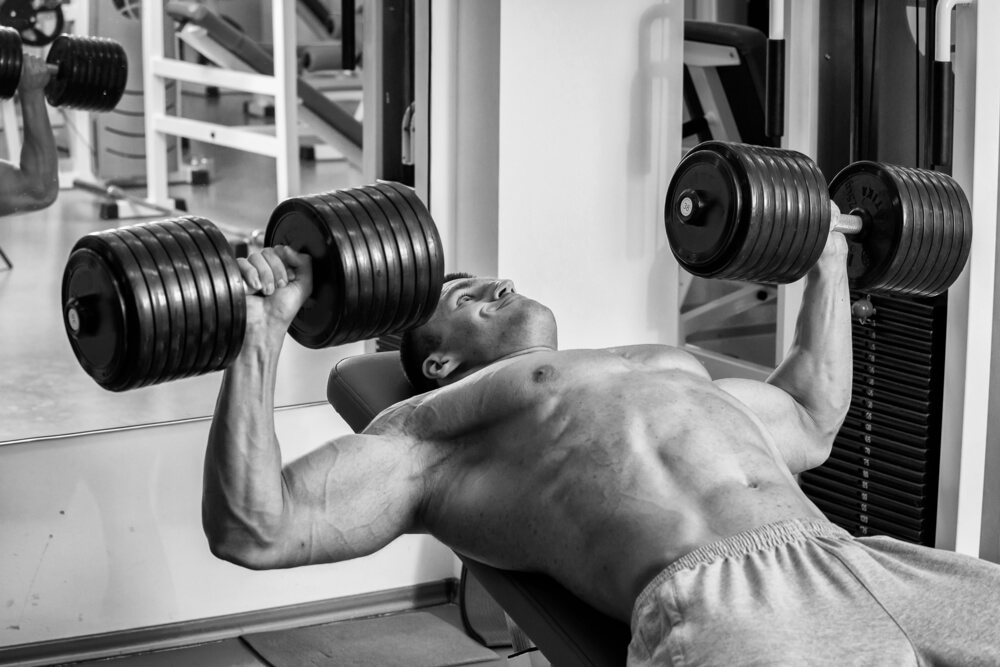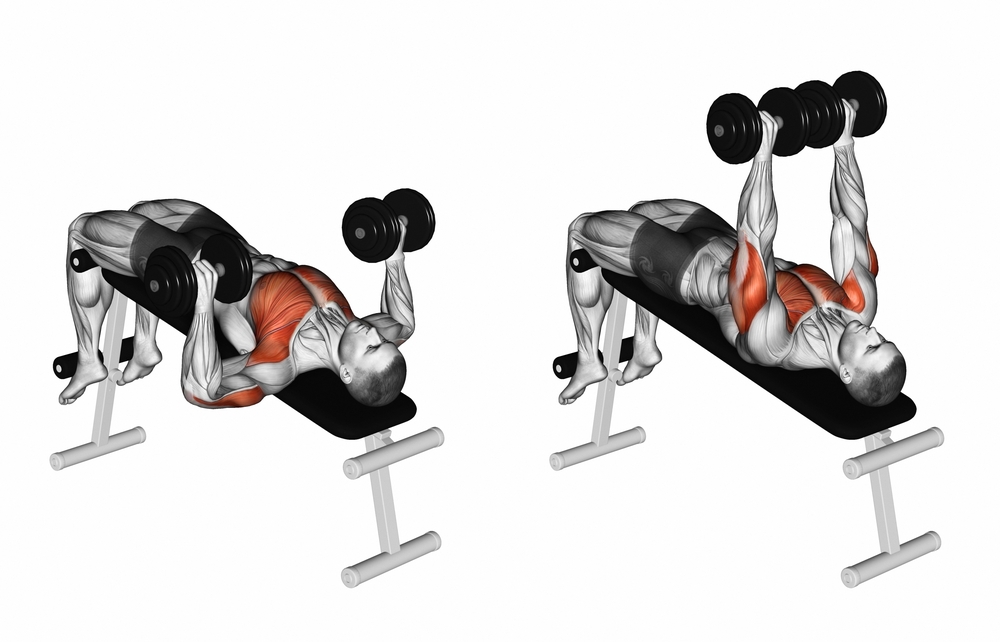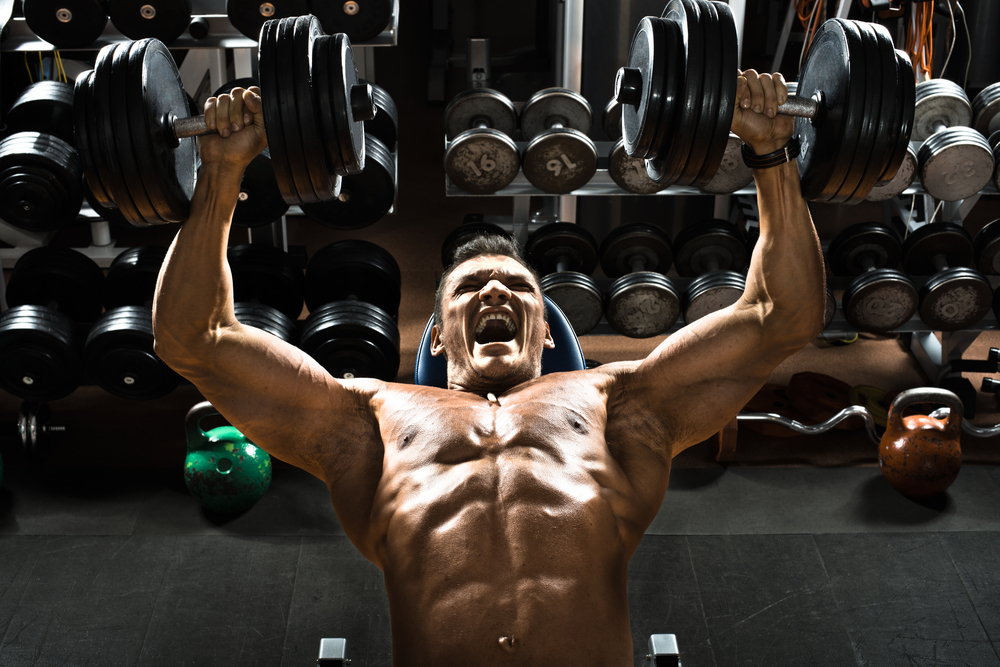Upper body day really is what gets you up in the morning (if you’re like most people). Sure, leg day blasts more calories and a solid butt can turn heads, but a powerful chest, tree trunk arms and wide shoulders are realistically why some are in the gym.
Naturally, you pump out reps of the traditional barbell bench press, and most other upper body lifts hit the chest in some shape and form, but if you’re limiting yourself to only the traditional lifts, you’re cutting yourself short. Not only are you not working the pectoral muscles completely but you’re missing out on several great upper body workouts, including the incline dumbbell press.
What makes the incline dumbbell press so great and why should you add it to chest days?
We’ve got all the answers to your questions right here.
Breaking Down Your Pecs
To fully understand (and appreciate) the importance of not only multiple chest workouts but varying lift positions (incline and decline), you first need to understand the pectoral muscles.
When you look in the mirror or even feel your pecs, you wouldn’t be alone if you believed it to be a single muscle on each side.
This, however, it not accurate. The chest is broken down into several different major muscle groups. First, there is the pectoralis major. This makes up the majority of your chest muscle and it is what your traditional bench press works. It is shaped like a fan (the foldable kinds made famous by movies of the Orient and women inside pre-AC churches).
Above the pectoralis major (the fan portion of the muscle is also referred to as the sternal head) is the clavicular head. Technically still part of the pectoralis major, it is the connecting tissue to your neck and your arm.
The pectoralis minor sits underneath the pectoralis major and attaches to your 3rd, 4th, and 5th rib. This muscle group is more designed to stabilize your upper body. As a stabilizer muscle, it is activated typically with free weights (especially dumbbells).
The serratus anterior is a thin lateral strip of muscle that runs along the chest wall and attaches to the 1st through 8th ribs. These muscles are used to help with lifting your arm beyond a 90-degree bend.
Lastly, there is the subclavius, which is the smallest muscle in the pectoral grouping. It is found right under your clavicle and has a horizontally elongated shape to it. It is located right along the first rib and is used as an anchor for the clavicle (Teach Me Anatomy, 2017).
What Your Regular Chest Lifts Work
Most of the major chest lifts you likely perform start with you either laying flat on your back or sitting at 90 degrees at a fly machine (or standing 90 degrees at the cable machine).
When laying perfectly flat or sitting/standing at a 90-degree angle, almost all of the weight and tension is placed in the middle of the chest.
This means you’re primarily working the pectoralis major.
This is the largest muscle in the chest and, as it is the most defined, it makes sense why you would want to work this area.
However, you probably don’t even realize you’re missing out on the entire top portion of the chest. The upper chest is one of the most underdeveloped areas of the upper body and it happens on accident. Without proper knowledge and education, the average lifter would be excused if they assumed the traditional bench press and chest fly exercises worked the entire chest.
The clavicular head of the pectoralis major goes almost completely untouched though, which is a major reason why you need to add the incline dumbbell press to your chest day.
The Incline Press
When you hit the gym, you’ll probably find the bench of the traditional bench press can either rise to an incline or drop to a decline (the decline bench itself is another solid chest workout to consider, although that is an entirely different article). With the incline press, you’re a bit at the disposal of the bench itself as to the exact angle. Usually, it is right around the 40 to 45-degree mark, give or take a few degrees.
With the incline press, you’re a bit at the disposal of the bench itself as to the exact angle. Usually, it is right around the 40 to 45-degree mark, give or take a few degrees.
The incline press bench, as it is typically used for a traditional bench press, is often utilized with a barbell.
While you’re more than welcome to perform a barbell incline press, the barbell variation works your muscles in a different way and offers more benefits than the barbell (more on this later). Of course, if this is your only option it is far better to take advantage of a barbell than nothing at all.
The incline press move itself is nearly identical to that of a bench press. As you’re using dumbbells instead of a barbell you’ll begin with the weights at chest level. From there you push the dumbbells up to almost fully extended (just avoid locking your elbows) before lowering the weights back down. This is one rep (ExRx Network, 2017).
The Advantages of Incline Dumbbell Press
With the barbell right there at the bench press, why should you opt out and instead take advantage of the dumbbells?
There are a few good reasons for this. First, if you’re already using the barbell for a regular bench, you’ll max yourself out with this move. While lifting heavy is your choice (depending on if you want to go for the strength or size), dumbbells give you additional stabilizing work. With a barbell your two arms work together, keeping the weight steady.
However, as each dumbbell is an individual weight, your arms are isolated, forced to work independently of the other arm.
This engages smaller muscles in your arm, shoulders, back, and chest to help keep the weight steady. While stabilizing muscles are at work with a barbell (especially over a machine press), nothing engages the body like a dumbbell.
Advantages of Incline Barbell Press
Where there is an advantage there is always a disadvantage, right?
Well, in this case, there is, although it depends on a bit on you. If you are already benching heavy on a traditional bench press using a barbell you’ll already hit the large muscles of the pecs, back, shoulders and arms with the heaviest weight possible.
Due to this, you likely won’t be able to lift as heavy with the incline bench anyway. However, even with that said, chances are you can’t lift as heavy with dumbbells (although having a spotter assist with your initial position can help a bit). So, where you gain in muscle engagement and stabilizer usage you’ll lose a bit of total weight.
The second disadvantage of using a dumbbell compared to a barbell is arm placement.
You only really have one hand placement option with the dumbbells. This is because the laws of gravity take over if you attempt to hold the heavy dumbbells out to the side, which opens you up for injury. With a barbell you don’t have that kind of a problem, so you do have a bit more leeway in terms of hand placement.
The Benefits of Incline Dumbbell Press
Whether you take advantage of individual dumbbells or you decide to go with a barbell, the incline bench offers a major benefit you need to take advantage of.
As mentioned earlier, the clavicular head of the pectoralis major goes almost completely untouched during a traditional bench press and upper body workout. With your bench positioned at an incline, the weight does not go up and down over the sternal head of your pectoralis major. Instead, the weight is positioned right above the clavicular head. This fully engages the clavicular head, forcing it to act as the major muscle used for this lift. The sternal head then acts as a stabilizer muscle instead of the main muscle for the lift.
Due to the incline bench position, few other lifts actually place this kind of tension on the clavicular head.
This makes the incline bench unique in how it targets your body. It also makes the incline dumbbell press a must for your chest day workouts.
Proper Form during the Incline Dumbbell Press
The most difficult part of this lift, especially if you are lifting heavy, is reaching the starting position.
This is because unlike the barbell press, you don’t have a rack above your head. You just have these two heavy weights sitting there. So begin by lifting each weight up to your thigh. Lay back onto the incline bench and use your thighs to assist in pushing your weights up to your chest.
Once you have your arms fully under the weight position the weights where the side of your chest comes together with your shoulders. Do not let the weights rest on your body once you engage. You want your arms and chest to hold the weight up at all time. This works your chest throughout the entire lift.
Breathe in, then push the weights up on the exhale. Keep your arms tight together. If this is your first time performing the lift you may want to start off lighter until your muscles are accustomed to the slightly different press movement. If you’re not careful and lose concentration it is easy for your elbows to sag and sway. If the weight begins to pull in one direction drop the weights. If you don’t, you can tear your shoulder and peck muscles.
Hold the weight at the top of the press with slightly bent elbows, then lower the weights back down, again hovering right above your chest before pushing the weight back up for another set.
When to Perform The Incline Dumbbell Press
Treat the incline dumbbell press much like you would the bench press. If you’re going for strength gains shoot for 1-4 reps (trying to max out on dumbbells is difficult as you might not be able to reach your starting position without a spotter). If you are shooting for size go for 8 to 12 reps. Whatever category you fall under, perform 3-4 sets.
Now, here’s an issue some people face. Let’s say you have the heaviest weight you can actually load up to your starting position, but you’ll surpassing either the four or 12 rep max of the strength/size gains you’re looking for.
What are you suppose to do?
Slow it way down. Sure, you could pick up a few 30 pounders and blow through a few dozen reps no problem, but that isn’t going to do you much good. Instead, push the weight up slowly, using a count of two.
Hold the weight in the top position for a two count, lower the weight for a two count and hold the weight, not touching your chest, for a two count. This slow movement forces your muscles to extend the time engagement while also working both your fast and slow twitch muscle fibers (you can read more on slow and fast twitch muscle fibers in another article on the site). If you’ve never lifted real slow before you will be surprised as to just how well it works your upper chest muscles, on top of your upper back, shoulders and really the rest of your upper body (even your stabilizer muscles get extra work).
The best time to perform this workout is towards the beginning of your chest day routine.
As this is probably one of the weaker areas of your chest you should hit it before your stabilizer muscles are torched and you can’t put in the needed effort. You may even want to put it at the front, above your regular bench press, from time to time to ensure maximum effort from the upper chest.
Conclusion
Your chest exercises are the money makers for the upper body. You’ll work your chest, shoulders, arms, and back. So take advantage of lifts like the incline dumbbell press to maximize your gains on both strength and size.
The next time you’re at the gym or working out at home, make sure to add the incline dumbbell press to your chest exercises.
You won’t be disappointed.
-Terry Asher
Terry Asher
Latest posts by Terry Asher (see all)
- Better Family – Product Review Liquid Daily 2 oz - Dec 16, 2024
- Post-Workout Recovery: The Key to Optimal Performance - Nov 25, 2024
- Pre-Workout Supplements – Everything You Need To Know - Nov 18, 2024













[…] post Incline Dumbbell Press – Why You Should Add It To Chest Days appeared first on Gym […]
Great Article! Solid information, no fluff! It’s helped me tremendously in improving my flat bench too!
Thank you, Tony, glad it helped you out!
-Terry Asher
Awesome well explained!! One of my standards on chest day!!
Thank you, Mike! And I agree on a must on chest day!
-Terry Asher
[…] a medicine ball, hold onto the medicine ball instead of using just your hands. You can also use a light dumbbell if you don’t have a ball. Next, left your feet off the […]
[…] better off using an incline between 60-75°. The movement will be an arc in front of the torso. An incline allows for a range of motion that will be the most optimal for focusing on the anterior delts and […]
[…] dumbbell presses of 5 sets of 10 reps with a 40 pound dumbbell, and 4 sets of 20 reps with a 25 pound […]
[…] Dumbbell Presses of 5 sets of 10 reps with a 40 pound dumbbell, and 4 sets of 20 reps with a 25 pound […]
[…] dumbbell Presses for 5 sets of 10 reps with a 40 pound dumbbell, and 4 sets of 20 reps with a 25 pound […]
[…] dumbbell presses of 5 units of 10 reps with a 40 pound dumbbell, and 4 units of 20 reps with a 25 pound […]
[…] dumbbell presses of 5 sets of 10 reps with a 40 pound dumbbell, and 4 sets of 20 reps with a 25 pound […]